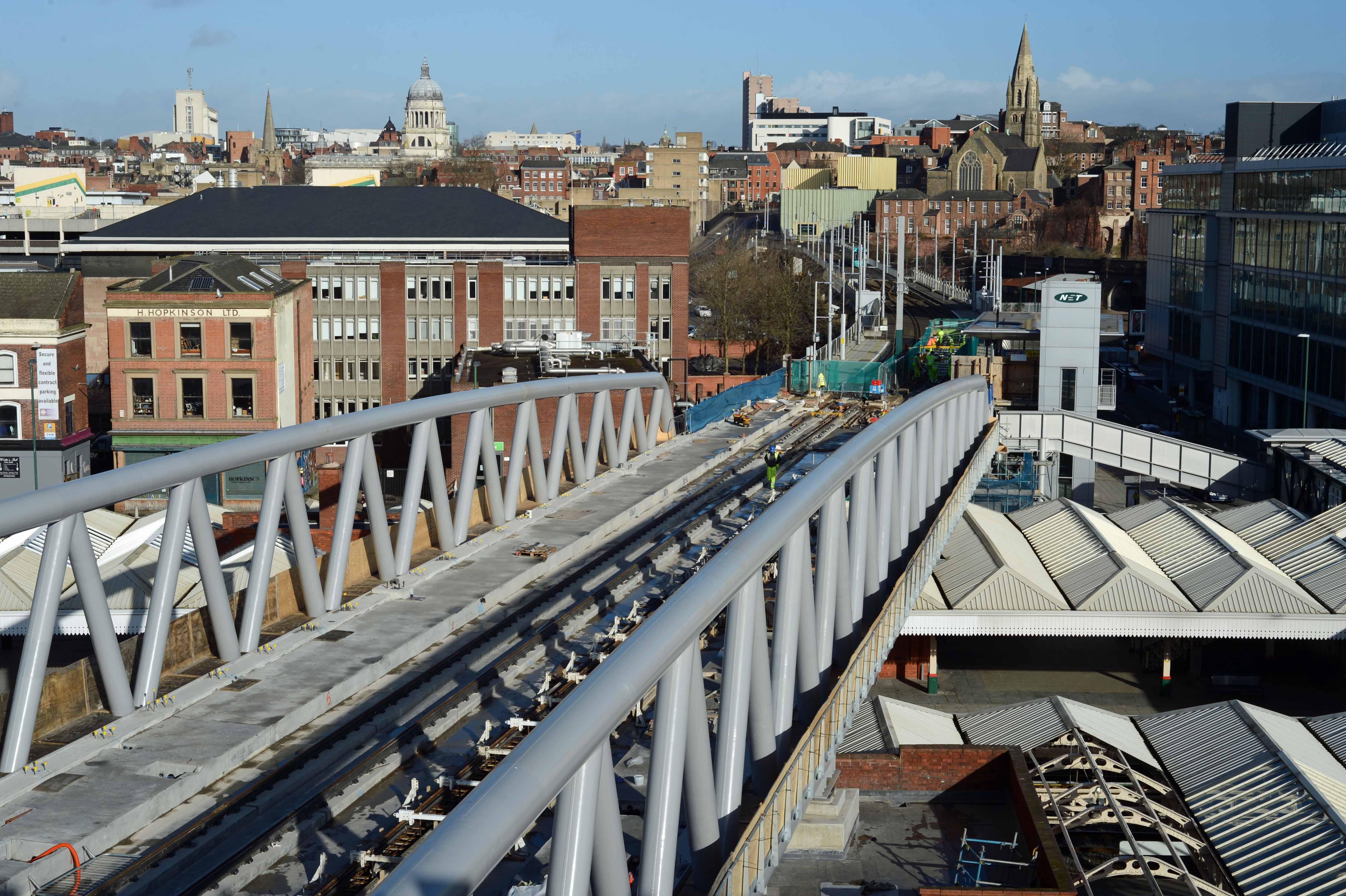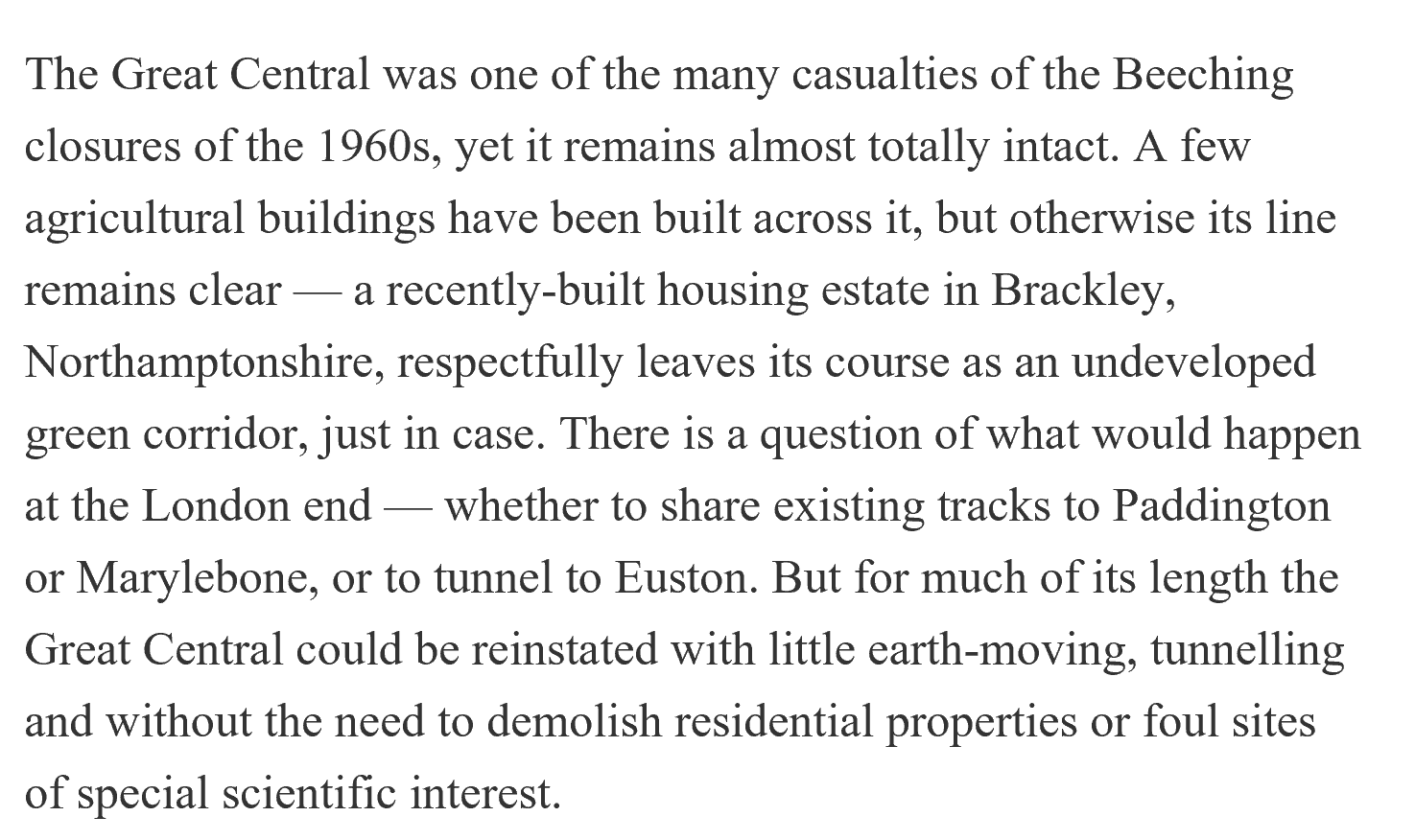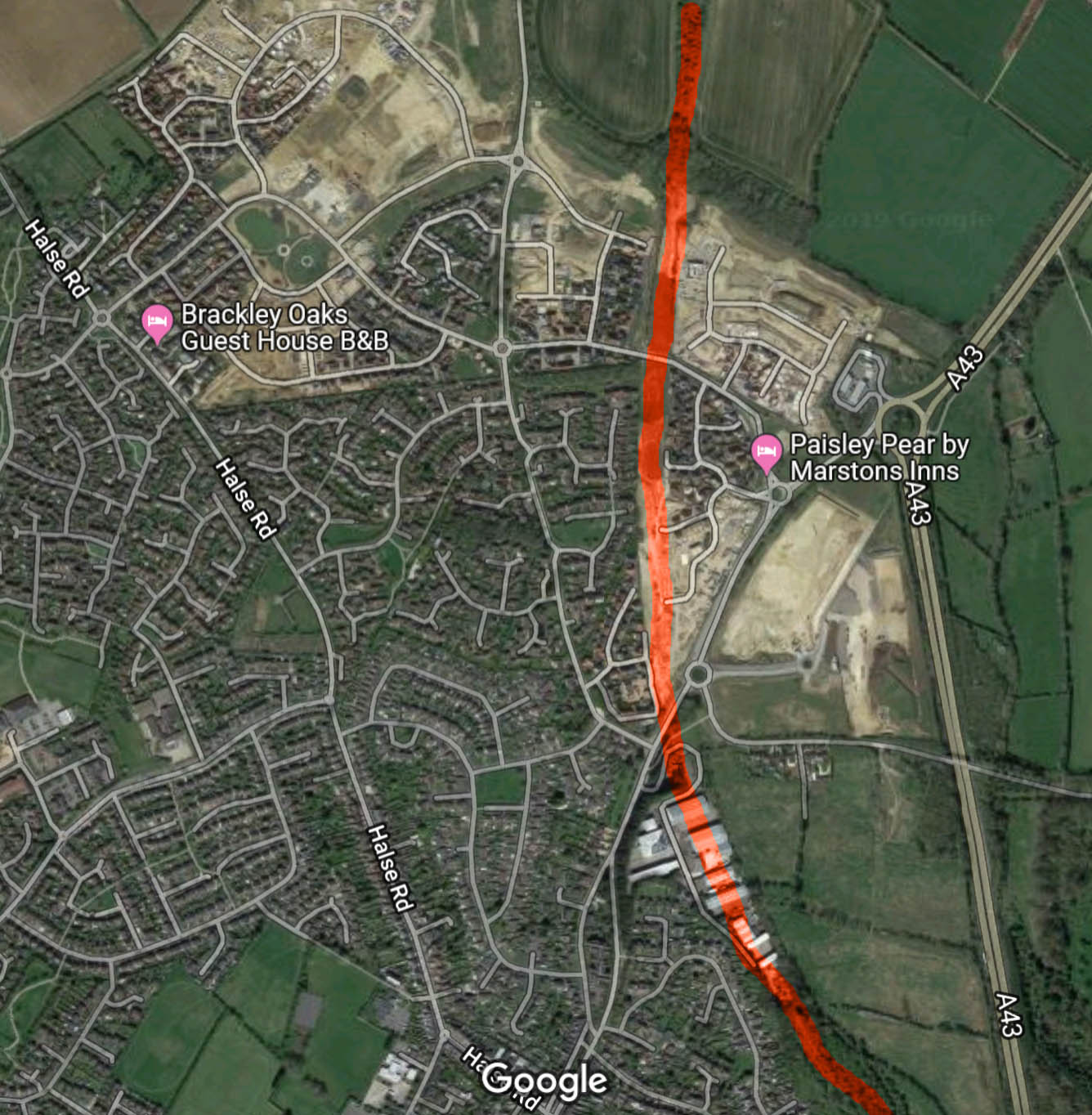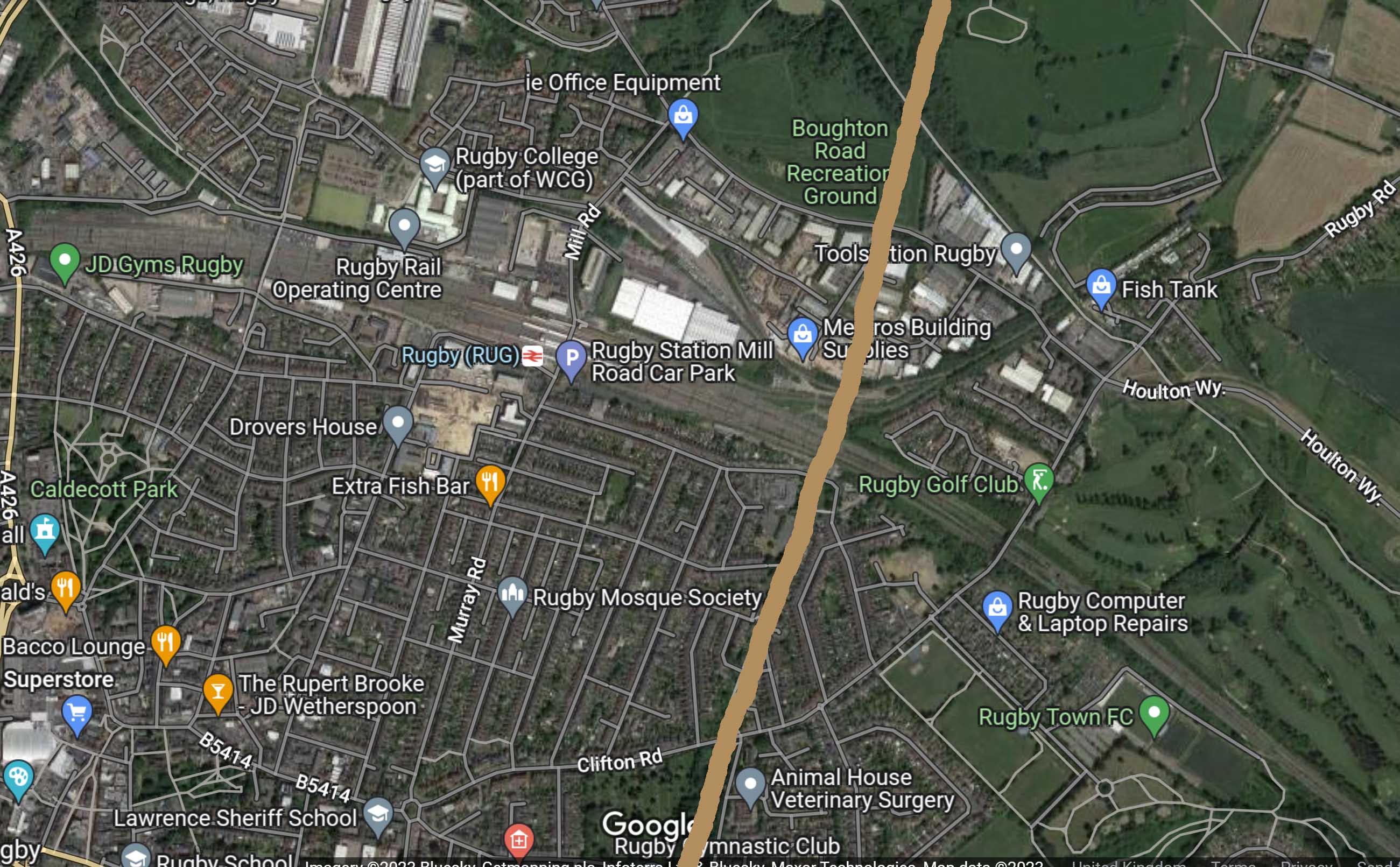Every so often, an article appears in ‘The Spectator’ where the sole intention is to knock HS2. Don’t be fooled into thinking the ‘speccie’ is somehow a magazine of independent mind. It’s the house journal and propaganda sheet for the far-right of the Tory party. It’s also famous for producing fiction masquerading as fact. It has a long history of getting it wrong on events around HS2. In fact, if you believed everything you ever read in the rag, HS2 should have been stillborn.
The latest mountain of rubbish comes from one Ross Clark, a man who’s clearly a stranger to knowing anything about the subject, or even bothering to do the slightest research on it. He’s come up with this nonsensical piece called “There is a far better option than HS2, and it already exists.
Yes, you’ve guessed it, he’s blathering on about re-opening the Great Central railway! For some reason, the Great Central is one of those totemic issues to people of a certain age, not all of them are railway enthusiasts, although many of them are. It’s symptomatic of England being stuck in the past rather than looking positively to the future, ‘cos for a ‘bright’ future, all we have to do is bring back the past, obviously! You can see this bonkers thinking in the whole Brexit shambles. Anyway, I digress. Let’s have a look at some of Clark’s claims.

I’m struggling to find a single factual statement in this. Where to start? It takes the same route as HS2? No, it doesn’t. The nearest to Birmingham the GC went was Rugby, after which it headed North to go to Leicester, Nottingham and Sheffield. There’s a clue in its name! Its viaducts and bridges are ‘unused’? Well, ignoring the fact many of them have been demolished, that would be news to the good citizens of Nottingham, as much of the city centre formation of the GC has been incorporated into the new tramway, and the site of Nottingham Victoria is now a shopping centre. Here’s an illustration of the scale of changes in Nottingham.

This shot was taken in 2014. It shows the new tram route crossing over the centre of the remaining Nottingham station. It’s built on the course of the Great Central, which crossed the station in exactly the same spot, only that was demolished years ago. This bridge now links the two separate sections of the NET tramway. Remove this and you cut the new tram network in half. Not only that, but the remaining formation of the GC is used by NET in the background. The GC’s ‘almost totally intact’? Pfft!
This website has a great selection of pictures documenting the demolition of the Great Central around Nottingham.
As you can see, the idea that the tracks were ripped up 53 years ago, leaving the formation untouched until the present day is just a load of cobblers, frankly. For example, much of the GC’s route through Leicester was demolished by the beginning of the 1980s whilst the famous bowstring bridge was dismantled in 2009. Here’s a fascinating website that documents the demolition of the Great Central’s infrastructure around Leicester. It blows Clark’s claims out of the water.
At Rugby, the huge ‘birdcage’ bridge that used to carry the GC over the West Coast Main line was demolished in 2006. There’s also a large industrial estate to the north now. It’s the same with the 223m long viaduct at Brackley, which was demolished in 1978. There’s also the small matter that a couple of chunks of the GC around Loughborough are now part of the preserved Great Central railway. They had to reinstate the bridge over the Midland Main Line at great expense and any battle to reclaim the route from them would be rather expensive I imagine! Oh, talking of Blackley, William Barter’s sent me this link, which proves Clark couldn’t even get the bit about reopening the GC not affecting any SSSI’s right. Part of the GC route IS an SSSI!
The GC had ‘the fastest expresses in the country’? That’s a new one I’ve never heard before and I notice he offers no evidence for that claim. The GC had no ‘racing’ stretches like the LNER did on the East Coast main line, or the Great Western had on Brunel’s ‘billiard table’, it just had few stations on the London extension.
Then we get the age-old nonsense that the GC’s London Extension was built to ‘continental loading gauge’. No. It wasn’t. The most common guff you hear is that it was built to ‘Berne gauge’ – only Berne gauge wasn’t established as a standard until a 1912 conference (yes, you’ve guessed it – in Berne!) and wasn’t adopted until 1914, long after the GC London extension was opened. Yes, it does have a slightly more generous loading gauge than many other UK railways built earlier (but only on the London extension), but that’s not equal to any of the standards accepted in Europe and it certainly isn’t the same as the UIC standards trans-European railways like HS1 are built to. It’s also worth noting that many EU railways like Belgium, Germany and the Scandanavian countries use a loading gauge that’s far bigger than Berne.
Another howler is the claim that the GC London extension built as a high speed railway. Firstly, define ‘high-speed’? In the era the GC was built, 75mph was ‘high-speed’, it’s not now. The idea that to can just reinstate a few bridges, relay the track and whizz trains up and down it at 140mph as Clark asserts is just another fantasy. Of course, there’s a subtle irony about these high-speed claims. The London extension was high-speed because it was built as straight as possible through open country and had few intermediate stations so that expresses weren’t slowed down. All these are things opponents of Hs2 object to!
Here’s some more guff from Clark.

Right, we’ve already exposed the “almost totally intact” nonsense, but let’s really put that one to bed. The line remains ‘clear’ at Brackley? I’ve already mentioned the demolished viaduct there, but here’s a screengrab from Google maps showing the town itself. I’ve marked the old GC route in red.

If the line’s ‘clear’ at Brackley, what’s that big industrial estate towards the bottom of the picture then? I could produce map after map showing how little is actually left of the GC route on the ground, rather than in Clark’s imagination. Plus, does Clark seriously think that the residents of the new housing estate would welcome the idea of the place being cut in two by re-opening the GC? Nimbyism would be rife along the route, just as it has been with HS2, where plans to reuse part of the GC formation in Bucks met with opposition from Nimbys!
Now lets look at Rugby. There was never a connection between the Great Central and the LNWR at Rugby that faced towards Birmingham. THE GC passed over the LNWR on the famous ‘birdcage bridge’. To build any such connection now you would have to demolish a large part of the town! It’s utterly bonkers but then these people never let facts get in the way of their flights of fancy. Can you imagine the uproar in Rugby if anyone seriously suggested this? Here’s a map to illustrate the issue. I’ve drawn on the old route of the GC so you can see the problem.

Now let’s address the ‘question’ of the London end, which Clark poses but glibly ignores answering. Run into Marylebone? You’re having a laugh! Since the 1966 closure of the GC Marylebone’s fortunes have changed completely, once proposed for closure itself its now a very busy station run by Chiltern trains who added two more platforms in 2006 to cope with all the extra trains they run. There’s simply no spare capacity there, nor on the Metropolitan line tracks the route shares with London Underground heading up through Rickmansworth to Amersham. As for running into Paddington. that’s just as laughable, it’s yet another London terminus with no spare capacity. In the 50 years since the GC closed rail services have grown massively, a point totally ignored by Clark. He also mentions Euston but neglects to mention the fact HS2 is having to build a lot of new platforms there to cope. Here you see the beauty of being a writer who’s untroubled by reality, you can airly solve these problem with a few taps on your keyboard. In the real world however…
It’s time that we finally put to bed this fiction that re-opening the Grand Central is either possible, or desireable. We need to stop indulging in these flights of fancy into the past and start dealing with the reality of the future. One last point. The weather. Unless you’ve had your head buried in the sand these past couple of weeks you can’t have failed to notice that the weather is getting more extreme. Our Victorian rail network was built for an age when Climate Change wasn’t even considered. Now we know the truth. HS2 has been designed and will be built to cope with those ‘once in a century’ events that are now happening almost every year. We cannot rely on Victorian infrastructure forever.
I’ve a favour to ask…
If you enjoy reading this blog, please click on an advert or two. You don’t have to buy anything you don’t want to of course (although if you did find something that tickled your fancy would be fab!), but the revenue from them helps to cover some of the cost of maintaining this site – and right now (because of Covid), us locked-down freelances need all the help that we can get…
Thank you!

I wonder if anyone will try to counter this, we both no they won’t be able to. The GC as an alternative to HS2 is pure Uncle Joe myth.
Oh, they might try, but it won’t be with anything evidence based!
Brilliant rebuff
Absolutely brilliant analysis Paul – proper, serious work. Cheers, Nigel
Thank you! This rubbish in the Spectator really needed someone to expose it for what it was.
A portion of the GC north of Aylesbury will be re-used, and its going to make life difficult for the Buckinghamshire Railway Centre at Quainton Road station which has its buildings etc., on both sides of the tracks. In addition, this might prevent the running of Bank Holiday through trains from Aylesbury
Like so many things nowadays, the first step is (apparently) to invent a time machine and then go back to change government policy. Far simple than building HS2 obviously…
How about this statement: “the disadvantage of running trains at 225mph is that they can’t stop very often. As a result, HS2 misses out the towns which are most in need of regeneration: Stoke-on-Trent, Coventry, Leicester. Derby and Nottingham would be served by a station between the two — requiring a long tram ride to the centre of either. In Birmingham, HS2 trains would terminate at a new station, Curzon Street, rather than New Street, where all the connections are to other towns in the West Midlands. As for East Midlands airport — that is the most ludicrous situation of all. Which other country would burrow a high-speed rail line under the runway of an international airport and not have a station there?” Is that incorrect as well?
Your ‘statement’ is claptrap from start to finish, but typical of the made-up nonsense HS2 anti have always churned out. Your ‘map’ of HS2 would look like a squiggle drawn across the countryside! You don’t understand the basic concept of high-speed rail or any of the discussions that have gone on for years about the route. Here’s a clue. If it stops everywhere, it’s not high-speed, is it? Birmingham New St? I guess you’ve never been there. It’s underground. It’s full. How do you build extra platforms there without demolishing a large chunk of the city centre? You’ve no idea, but then you don’t really care. All you care about is stopping HS2 because (and I’m taking a shot in the dark here), you’re a Nimby and it comes near you. East Midlands an ‘international’ airport? It’s used by charter companies into Europe and it’s hardly a busy airport and it’ll be less so now with the collapse of Thomas Cook, who were one of its main users. It’s used more by freight. There’s no justification for building a station there. Still. facts eh? This is why the anti HS2 ‘campaign’ has always been useless. Your motivation is the stop HS2 and any old excuse will do…
All those towns will receive better local and regional services via capacity that is released via long distance traffic that doesn’t call at them now being moved to HS2. As to Nottingham and Derby many in an arc from the north to the south, and east for Derrby and west for Nottingham, of the cities will find it easier to get to Toton than they will to the existing city centre stations as they aren’t fighting peak traffic flowing into the city centres, so the cities should see beneficial reductions in traffic loads on key routes and more capacity released at the city centre stations. Curzon St is a 5 minute walk from New St and all of the Bull Ring is equidistant between them. I’m sure an improved walking route will be provided and the Tram will run between the Stations.
At last!! Someone, perhaps far more educated than I, who gets the notion the old GC isn’t viable as an alternative.
To be honest, even HS2 see the benefits of reconnecting Aylesbury to the EWR and are leaving the infrastructure open for it to happen. A sensible notion thats been poo-poo’d by EWR and this totally incompetent government.
Thank you for a fascinating and much needed sensible read.
Ok you have made your point. Yes the Great Central was closed .the question I am asking is if it had not been closed, or the line “mothballed” could part of it be incorporated into HS2. The Beeching / Marples fiasco will still haunt this country for many years